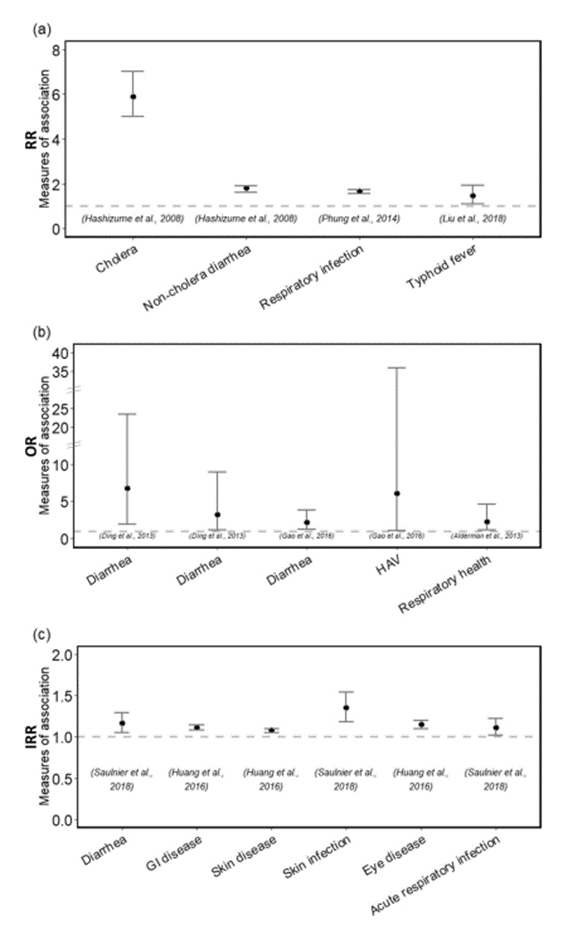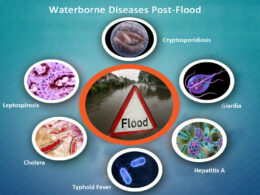Water-related disasters and their health impacts: A global review
Progress in Disaster Science (Elsevier)
Jiseon Lee, Duminda Perera, Talia Glickman, LinaTaing
August, 2020
Mental health problems.
Mental health problems as flood-related diseases have been studied extensively. Deteriorated mental health resulting from floods is usually due to comorbid physical health problems, financial losses, and community or social disruption[1] . Among people who were exposed to floods, those who perceived they had other health issues, or those who had preconceptions about the connection between floods and mental health, were purported as potential factors for reporting worsening mental health[2] [3]. Post-Traumatic Stress Disorder (PTSD) was one of the most common illnesses reported on in the case studies[4] [5] [6] [7] [8] [9]. Various studies have noted, through both self-reporting and diagnostic criteria, that PTSD symptoms tend to increase after floods, with the severity of each case varying with subjective experiences[10] [11]. In a study looking at the mental health problems of the 2010 flood in Pakistan, all flood victims in the sample met the PTSD diagnostic criteria[12]. It has been observed that prescriptions of anti-anxiety medications and sleep aids have increased during and after certain flood events, and antidepressant prescriptions increased post-flood[13] [14]. Increased anxiety, psychological distress, and decreased overall mental health have been reported[15] [16] [17] [18]. Factors such as increased stoicism, maladaptive coping, and, in children, pre-flood behavioral problems, may lead to adverse mental health effects after flooding[19] [20]. In Fig. 8, all mental health impacts had ratios higher than the null, indicating a positive association with the impact and floods.

Malnutrition.
Malnutrition is not a common flood impact investigated in the selected studies. When examining the relationship between the nutrition of children and flooding in Eastern India, the prevalence of wasting was highest in the community affected by flooding in 2006 and 2008 (51.6%), second highest in a community affected by flooding only in 2008 (41.4%), and lowest in a community not affected by floods (21.2%)[21]. Another study reported that 90% of households were forced to eat less during or shortly after a flood, potentially suffering from undernutrition[22].

Fig. 6. Main Health Risks by Floods. (a) RRs, (b) ORs, and © IRRs with 95% confidence intervals
Fig. 7. Health Risks of Water-borne Diseases by Floods. (a) RRs, (b) ORs, and © IRRs with 95% confidence intervals

References
[1] AldermanK,TurnerLR,TongS.Floods,andhumanhealth:asystematicreview.Environ Int. 2012;47:37–47.
[2] Alderman, K.; Turner, L.R.; Tong, S. Assessment of the Health Impacts of the. Floods in Brisbane. Disaster Med Public Health Prep. 2011 Summer;2013(7):380–6.
[3] Paranjothy S, Gallacher J, Amlôt R, Rubin GJ, Page L, Baxter T, et al. Psychosocial impact of the summer 2007 floods in England. BMC Public Health. 2011;11:145.
[4] World Health Organization (WHO). Flooding and communicable diseases fact sheet. WHO; 2012.
[5] Parker DJ. Floods. Taylor & Francis; 2000 ISBN 978–0–415–22743–8.
[6] RashidS. The urban poor in Dhaka City: their struggles and coping strategies during the f loods of 1998. Disasters. 2000;24:240–53.
[7] Bei B, Bryant C, Gilson KM, Koh J, Gibson P, Komiti A, et al. A prospective study of the impact of floods on the mental and physical health of older adults. Aging Ment Heal. 2013;17:992–1002.
[8] Chung MC, Jalal S, Khan NU. Posttraumatic stress disorder and psychiatric comorbidity following the 2010 flood inpakistan: exposure characteristics, cognitive distortions, and emotional suppression. Psychiatry Interpers Biol Process. 2014;77:289–304.
[9] Peng M, Liu A, Zhou J, Wen S, Li S, Yang T, et al. Association between posttraumatic stress disorder and Preflood behavioral characteristics among children aged 7–15 years in Hunan. China Med Princ Pract. 2011;20:336–40.
[10] Bei B, Bryant C, Gilson KM, Koh J, Gibson P, Komiti A, et al. A prospective study of the impact of floods on the mental and physical health of older adults. Aging Ment Heal. 2013;17:992–1002.
[11] ] Chung MC, Jalal S, Khan NU. Posttraumatic stress disorder and psychiatric comorbidity following the 2010 flood inpakistan: exposure characteristics, cognitive distortions, and emotional suppression. Psychiatry Interpers Biol Process. 2014;77:289–304.
[12] Chung MC, Jalal S, Khan NU. Posttraumatic stress disorder and psychiatric comorbidity following the 2010 flood inpakistan: exposure characteristics, cognitive distortions, and emotional suppression. Psychiatry Interpers Biol Process. 2014;77:289–304.
[13] Milojevic A, Armstrong B, Wilkinson P. Mental health impacts of flooding: a controlled interrupted time series analysis of prescribing data in England. J Epidemiol Community Heal. 2017;71:970–3.
[14] Sahni V, Scott AN, Beliveau M, Varughese M, Dover DC, Talbot J. Public health surveillance response following the southern Alberta floods, 2013. Can J Public Heal. 2016; 107:e142–8.
[15] Srikuta P, Inmuong U, Inmuong Y, Bradshaw P. Health vulnerability of households in f looded communities and their adaptation measures: case study in northeastern Thailand. Asia Pacific J Public Heal. 2015;27:743–55.
[16] World Health Organization (WHO). Flooding and communicable diseases fact sheet. WHO; 2012.
[17] Wade TJ, Sandhu SK, Levy D, Lee S, LeChevallier MW, Katz L ,et al. Did a severe flood in the Midwest cause an increase in the incidence of gastrointestinal symptoms? Am J Epidemiol. 2004;159:398–405.
[18] Bei B, Bryant C, Gilson KM, Koh J, Gibson P, Komiti A, et al. A prospective study of the impact of floods on the mental and physical health of older adults. Aging Ment Heal. 2013;17:992–1002.
[19] Bei B, Bryant C, Gilson KM, Koh J, Gibson P, Komiti A, et al. A prospective study of the impact of floods on the mental and physical health of older adults. Aging Ment Heal. 2013;17:992–1002.
[20] Peng M, Liu A, Zhou J, Wen S, Li S, Yang T, et al. Association between posttraumatic stress disorder and Preflood behavioral characteristics among children aged 7–15 years in Hunan. China Med Princ Pract. 2011;20:336–40.
[21] Rodriguez-Llanes JM, Ranjan-Dash S, Mukhopadhyay A, Guha-Sapir D. Flood-exposure is associated with higher prevalence of child undernutrition in rural Eastern India. Int J Environ Res Public Health. 2016:13.
[22] Braun B, Aßheuer T. Floods in megacity environments: vulnerability and coping strategies of slum dwellers in Dhaka/Bangladesh. Nat Hazards. 2011;58:771–87.








